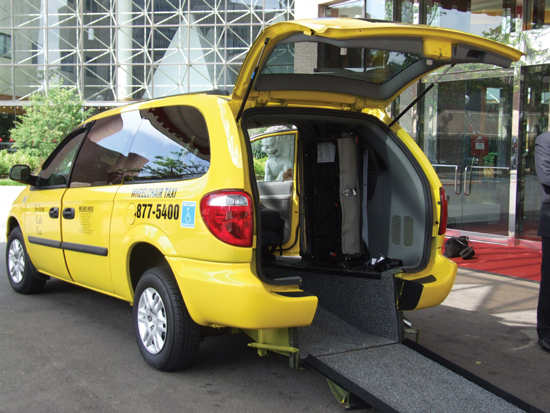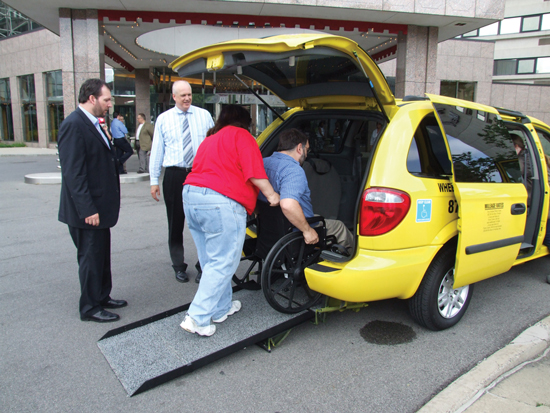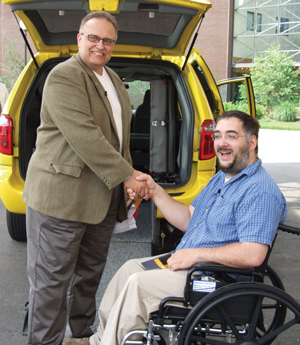
TLPA
ASSESSING THE FULL COST OF IMPLEMENTING AN ACCESSIBLE TAXICAB PROGRAM
NEW TLPA/TLPF PUBLICATION IS AVAILABLE

The Taxicab, Limousine & Paratransit Association is pleased to announce the availability of a new publication, Assessing the Full Cost of Implementing An Accessible Taxicab Program. This study was prepared for the Taxicab, Limousine & Paratransit Foundation by the Center for Transportation Studies, University of Missouri-St. Louis under the direction of Ray Mundy, Ph.D. for the TLPF. This report addresses the cost issues and operational difficulties that are often associated with the development of accessible taxicab service resulting from the local expansions of ADA type legislation. The report also includes software, the Accessible Taxicab Cost Calculator, that allows companies to calculate and evaluate the costs associated with implementation of an Accessible Taxicab Program. Following is a brief summary of the report which may be downloaded from the TLPA Web Site at www.tlpa.org.
On July 26, 1990, the American with Disabilities Act (ADA) was signed into law by President George Bush in order to eliminate discrimination based on physical and mental disabilities. The term disability is defined in the law as “a physical or mental impairment that substantially limits a major life activity."
The ADA consists of five main sections:
1. employment,
2. public services and public transportation,
3. public accommodation and commercial facilities,
4. telecommunications, and
5. miscellaneous provisions.
Our concern is with those aspects of the law that apply to privately provided public transportation commonly known as “taxicabs.” Although the ADA specifically exempts automobile type vehicles, including most taxicabs, from the requirement to be wheelchair accessible, it has greatly affected the taxicab industry in the United States:
— the cost of an ADA compliant vehicle,
— operating costs such as fuel due to decreased gas mileage/efficiency,
— liability insurance,
— training,
— vehicle productivity,
— passenger assistance on ingress and egress, and, perhaps, vehicle shipping.
— Finally, for those communities that have mandated wheelchair accessible taxicab services there is the problem of having an independent contractor driver willingly accept these trips, a topic that is fully addressed by this study.
Fortunately, there are many different positive approaches being taken by communities and taxi companies to achieve greater mobility for the transportation disadvantaged:

 |
Bill Yuhnke, owner of Liberty Cab in Buffalo, NY, is shown greeting a passenger by one of Liberty’s accessible taxicabs. |
Each of these situations, their costs and long term benefits to taxi companies, users and communities alike are discussed within:
The practical difficulties in the taxicab industry that arise from the enactment of local ADA type initiatives include additional incurred fixed and variable costs, low demand, and greater service time consumption resulting in lower revenue per trip and per vehicle. However, there are various alternatives and incentives for ADA compliant taxi vehicles and companies to overcome these practical difficulties. Communities should not simply mandate wheelchair accessibility without consideration of these practical difficulties.
The successful integration of taxicabs into this ADA accessible market depends upon existing regulatory structure for taxicabs, per trip subsidies, other accommodations a taxi company might receive from its local authority and the environment in return for their successful adoption by the taxi industry. Furthermore, agencies, which impose these local unfunded mandates often fail to monitor and evaluate their success or failure once mandated. As an example, some cities have provided new wheelchair accessible taxi permits at a substantially lower cost than standard sedan permits, but have then failed to assess how many actual wheelchair trips are being provided.
Unfortunately, many of the financial costs and benefits associated with these accessible services are not readily known. Through this report, its case examples, and associated cost evaluation software these costs can be replicated and reasonably determined for each local taxi company or driver. In addition, specific recommendations are provided for local authorities on how to make accessible taxicab services more successful in their community.
Overall, the report concludes that a small portion of integrated accessible taxicabs for curb-to-curb service is in the best long term interest of both the public and the taxicab companies. Additional costs of these services are real, however, and must be supported by the communities these taxicabs serve.
A final comment would be that one must consider the taxicab environment when initiating desired ADA taxicab services. If the community has a fractured taxicab system with many individual companies and no real full service taxi companies, implementation of an integrated ADA wheelchair accessible system will be extremely difficult and costly. Some progress might be possible with a centralized dispatch system which requires all taxicabs to accept calls. However, the economic realities are that the human behavior of the typical independent taxicab driver will work against the overall needs of the community to make these services available at reasonable and normal taxicab rates. In these situations, community leaders may have little choice but to directly contract ADA providers that schedule and deliver these publicly provided services.
The entire study, Assessing the Full Cost of Implementing An Accessible Taxicab Program, may be downloaded from the TLPA Web Site at www.tlpa.org.
Hal Morgan, TLPA’s Executive Vice President, provided this article. You may contact him at hmorgan@tlpa.org.